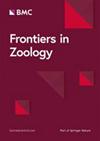Explosive regeneration and anamorphic development of legs in the house centipede Scutigera coleoptrata
IF 2.6
2区 生物学
Q1 ZOOLOGY
引用次数: 0
Abstract
Regenerating legs is advantageous for arthropods as their appendages exhibit crucial functional specializations. Many arthropods possess a ‘preferred breakage point’, where the appendage is most likely to break and where regeneration likely to occur, however, different taxa exhibit different levels of regenerative potential. Centipede appendage regeneration is categorized as 'progressive' or 'explosive'. In the later, the appendage is fully regenerated after one molt. This term was used for house centipedes that frequently lose their long legs. We chose Scutigera coleoptrata as a model to comprehensively investigate the process of leg appendotomy and regeneration as well as compare it with leg development in anamorphic instars. The trochanter exhibits a preferred breakage point. Internally, it houses a three-layered diaphragm that effectively seals the lumen. In case of leg loss, the wound is quickly sealed. The epidermis detaches from the cuticle and muscles of the coxa get compacted, giving sufficient space for the regenerating leg. A blastema forms and the leg then grows in a coiled manner. The regenerating leg is innervated and syncytial muscles form. If the leg is lost in an early intermolt phase, progression of regeneration is slower than when a specimen is closer to the next molt. Instars of house centipedes can simultaneously develop and regenerate legs. The legs develop laterally on the posterior segments under the cuticle. As opposed to regeneration, the progression of leg development always follows the same temporal pattern throughout the entire intermolt phase. Several factors are of major significance in house centipede leg regeneration. First, the ease with which they lose legs: the diaphragm represents an efficient tool for appendotomy. Moreover, the functional extension of the coxa provides space for a leg to be regenerated in. Lastly, the genetic predisposition allows them to regenerate legs within one molting cycle. This “package” is unique among land arthropods, and to this degree rare in marine taxa. Furthermore, observing leg regeneration and anamorphic leg development in parallel suggest that regeneration is most likely an epiphenomenon of development, and the differences are a requirement for the novel context in which re-development occurs.家养蜈蚣的爆炸性再生和腿的变态发育
腿的再生对节肢动物来说是有利的,因为它们的附肢具有重要的功能特化。许多节肢动物都有一个 "首选断裂点",即附肢最有可能断裂和再生的地方。蜈蚣的附肢再生分为 "渐进式 "和 "爆发式 "两种。在后一种情况下,附肢在一次蜕皮后完全再生。这一术语用于经常失去长腿的家养蜈蚣。我们选择库氏蜈蚣(Scutigera coleoptrata)作为模型,以全面研究腿部附肢切除和再生的过程,并将其与无形态阶的腿部发育过程进行比较。转子显示出一个首选的断裂点。其内部有三层隔膜,可有效密封管腔。一旦断腿,伤口很快就会被封住。表皮从角质层脱落,跗关节的肌肉被压缩,为再生的腿部提供了足够的空间。形成胚泡,然后腿以盘绕的方式生长。再生腿受到神经支配,形成合肌肉。如果在蜕皮间的早期阶段失去了腿,再生的速度会比接近下一次蜕皮时慢。家蜈蚣的蜕皮期可以同时发育和再生腿。蜈蚣的腿在角质层下的后节上侧面发育。与再生不同的是,在整个蜕皮间期,腿的发育始终遵循相同的时间模式。有几个因素对家养蜈蚣腿的再生具有重要意义。首先,它们很容易失去腿:横膈膜是一种有效的阑尾切除工具。此外,跗节的功能性延伸为腿的再生提供了空间。最后,遗传倾向使它们能够在一个蜕皮周期内再生出腿。这种 "组合 "在陆地节肢动物中是独一无二的,在海洋类群中也是罕见的。此外,同时观察腿的再生和拟态腿的发育表明,再生很可能是发育的附带现象,而差异则是再发育发生的新环境的要求。
本文章由计算机程序翻译,如有差异,请以英文原文为准。
求助全文
约1分钟内获得全文
求助全文
来源期刊

Frontiers in Zoology
ZOOLOGY-
CiteScore
4.90
自引率
0.00%
发文量
29
审稿时长
>12 weeks
期刊介绍:
Frontiers in Zoology is an open access, peer-reviewed online journal publishing high quality research articles and reviews on all aspects of animal life.
As a biological discipline, zoology has one of the longest histories. Today it occasionally appears as though, due to the rapid expansion of life sciences, zoology has been replaced by more or less independent sub-disciplines amongst which exchange is often sparse. However, the recent advance of molecular methodology into "classical" fields of biology, and the development of theories that can explain phenomena on different levels of organisation, has led to a re-integration of zoological disciplines promoting a broader than usual approach to zoological questions. Zoology has re-emerged as an integrative discipline encompassing the most diverse aspects of animal life, from the level of the gene to the level of the ecosystem.
Frontiers in Zoology is the first open access journal focusing on zoology as a whole. It aims to represent and re-unite the various disciplines that look at animal life from different perspectives and at providing the basis for a comprehensive understanding of zoological phenomena on all levels of analysis. Frontiers in Zoology provides a unique opportunity to publish high quality research and reviews on zoological issues that will be internationally accessible to any reader at no cost.
The journal was initiated and is supported by the Deutsche Zoologische Gesellschaft, one of the largest national zoological societies with more than a century-long tradition in promoting high-level zoological research.
 求助内容:
求助内容: 应助结果提醒方式:
应助结果提醒方式:


